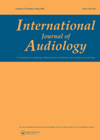
Journal Reviews
Impedance for different electrode types
Measuring cochlear implant (CI) electrode impedances is common in CI programming appointments to measure the integrity of the implant e.g. whether there are any open or short electrodes. This is because impedance measures the flow of current between intra and...
Clinical Practice Guideline on Tympanostomy Tube in Children Update (AAO-HNS)
The American Academy of Otolaryngology–Head and Neck Surgery Foundation’s ‘Clinical Practice Guideline: Tympanostomy Tubes in Children (Update)’ has been recently published - an update of the original 2013 guideline. This article forms an executive summary to accompany the full guideline....
Moving towards implanting children below 12 months of age
Newborn hearing screening has ensured that deaf infants are identified soon after birth so that habilitation can begin as early as possible. Cochlear implantation is a key component of early intervention for some children, but it is often not performed...
Loudness in non-organic hearing loss
Non-organic hearing loss has been of interest to researchers for a long time. In this study the authors compared a loudness rating measured in relation to the sound level for 1000 Hz in normal hearing patients and patients diagnosed with...
Cochlear implantation in asymmetric hearing loss
Criteria for cochlear implantation (CI) is a constant topic of debate. The UK traditionally had relatively restrictive guidance, although this has been greatly improved by more recent guidance released in 2019. Nevertheless, because of the lack of evidence for cost-effectiveness,...
How patients reacted to postponement of cochlear implant surgery due to COVID-19
The onset of COVID-19 in 2020 required widespread cancellation of elective surgeries, one of these being cochlear implant for profoundly deafened adults and post-lingually deafened children. Through a questionnaire, to which 23 out of 38 patients responded, this qualitative study...
Robotic insertion of electrode array in cochlear implantation
Cochlear implants (CIs) are commonly used for profound bilateral hearing loss. They have specific national guidance for their insertion, however patients with a substantial residual acoustic hearing are potential CI candidates. Preservation of this residual hearing can be sought with...
Do personal listening devices cause cochlear synaptopathy?
Cochlear synaptopathy is a condition in which noise interrupts the synaptic communication between sensory inner hair cells and low spontaneous rate cochlear nerve fibres. Since these nerve fibres are associated with signal coding in noisy backgrounds, their disruption leads to...
Prognostic value of vascular ultrasonographic findings in patients with idiopathic sudden sensorineural hearing loss
Sudden sensorineural hearing loss is often idiopathic. Although the aetiology of idiopathic sudden sensorineural hearing loss (ISSNHL) is unclear, vascular compromise is one of the frequently proposed hypotheses to explain its pathophysiology. Existing studies have shown an association between ISSNHL...
Algorithms to diagnose NIHL
Finding an efficient diagnostic tool for noise-induced hearing loss (NIHL) has been of research interest for a long time. There are several algorithms that compare expected age-related deterioration of hearing with the actual audiogram. This study aimed to compare a...
The basis of auditory processing disorder: what can we learn from corticals?
Auditory processing disorder (APD) is a poorly understood, heterogenous and surprisingly common condition. It manifests as a perceptual difficulty in centrally processing auditory information. Diagnosis is usually based on a variety of behavioural tests involving verbal and non-verbal assessments. In...
Cochlear implantation following radiotherapy treatment of vestibular schwannomas
The authors presented a case report and systematic review assessing the outcomes of patients from cochlear implantation (CI) following radiotherapy treatment for vestibular schwannoma (VS). Outcomes of cochlear implantation in these patients are uncertain due to the combination of both...















